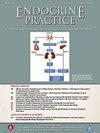钠-葡萄糖共转运蛋白2抑制剂治疗后2型糖尿病尿路感染患者的心血管结局:一项多中心观察研究
IF 3.7
3区 医学
Q2 ENDOCRINOLOGY & METABOLISM
引用次数: 0
摘要
目的:尿路感染(UTI)是钠-葡萄糖共转运蛋白2抑制剂(SGLT2i)的不良反应。然而,其对2型糖尿病(T2DM)患者心血管预后的影响尚不清楚。方法:这项多中心回顾性观察研究纳入了2016年1月至2019年1月期间接受SGLT2抑制剂(SGLT2i)治疗的糖尿病患者。主要不良心血管事件(mace)定义为非致死性心肌梗死、非致死性卒中、心源性死亡、全因死亡或因心力衰竭住院的综合事件。比较有和没有尿路感染(UTI)患者的结果。进行多变量分析以调整可能影响结果的基线特征。结果:我们回顾性分析了8862例接受SGLT2i治疗的T2DM患者。总共有550名患者在接受SGLT2i治疗后被确定为尿路感染并需要抗生素。我们对SGLT2i治疗后30个月的心血管预后进行了随访。在调整显著基线特征后,UTI组显示出MACE风险增加(aHR=2.03, 95% CI=1.60-2.57)。结论:slgt2i治疗后T2DM患者的UTI与MACE风险增加相关长达30个月。本文章由计算机程序翻译,如有差异,请以英文原文为准。

Cardiovascular Outcomes of Patients With Type 2 Diabetes With Urinary Tract Infection Post Sodium-Glucose Cotransporter 2 Inhibitors Treatment: A Multicenter Observational Study
Objective
Urinary tract infection (UTI) is an adverse effect of sodium-glucose cotransporter 2 inhibitors (SGLT2is). However, its effect on cardiovascular outcomes in type 2 diabetes mellitus (T2DM) patients remains unclear.
Methods
This multicenter retrospective observational study included diabetes patients who received SGLT2is between January 2016 and January 2019. Major adverse cardiovascular events (MACEs) were defined as a composite of nonfatal myocardial infarction, nonfatal stroke, cardiac death, all-cause death, or hospitalization due to heart failure. Outcomes were compared between patients with and without UTI. Multivariate analyses were conducted to adjust for baseline characteristics that might influence the outcomes.
Results
We retrospectively reviewed 8862 T2DM patients who had been treated with SGLT2i. In total, 550 patients were identified as having UTIs and requiring antibiotics after SGLT2i treatment. We followed up on the cardiovascular outcomes for 30 months after SGLT2i treatment. After adjusting significant baseline characters, the UTI group exhibited increased risk of MACE (adjusted hazard ratio [aHR] = 2.03, 95% confidence interval [CI] = 1.60-2.57, P < .0001), heart failure hospitalization (aHR = 1.66, 95% CI = 1.32-2.09, P < .0001), and all-cause mortality (aHR = 2.67, 95% CI = 2.10-3.40), P < .0001).
Conclusion
UTI in patients with T2DM post-SLGT2i therapy is associated with an increased risk of MACE for up to 30 months.
求助全文
通过发布文献求助,成功后即可免费获取论文全文。
去求助
来源期刊

Endocrine Practice
ENDOCRINOLOGY & METABOLISM-
CiteScore
7.60
自引率
2.40%
发文量
546
审稿时长
41 days
期刊介绍:
Endocrine Practice (ISSN: 1530-891X), a peer-reviewed journal published twelve times a year, is the official journal of the American Association of Clinical Endocrinologists (AACE). The primary mission of Endocrine Practice is to enhance the health care of patients with endocrine diseases through continuing education of practicing endocrinologists.
 求助内容:
求助内容: 应助结果提醒方式:
应助结果提醒方式:


